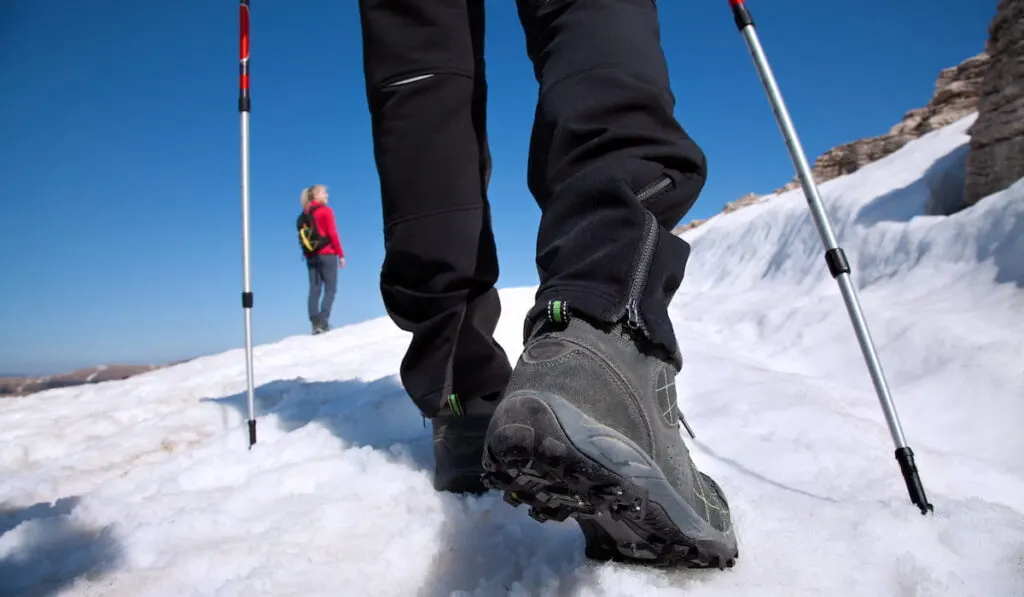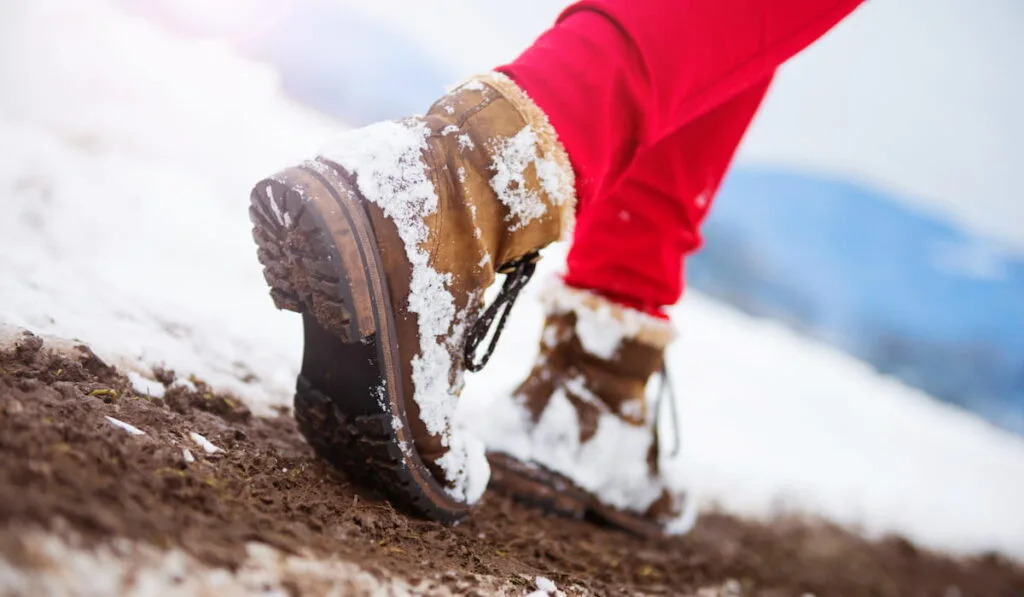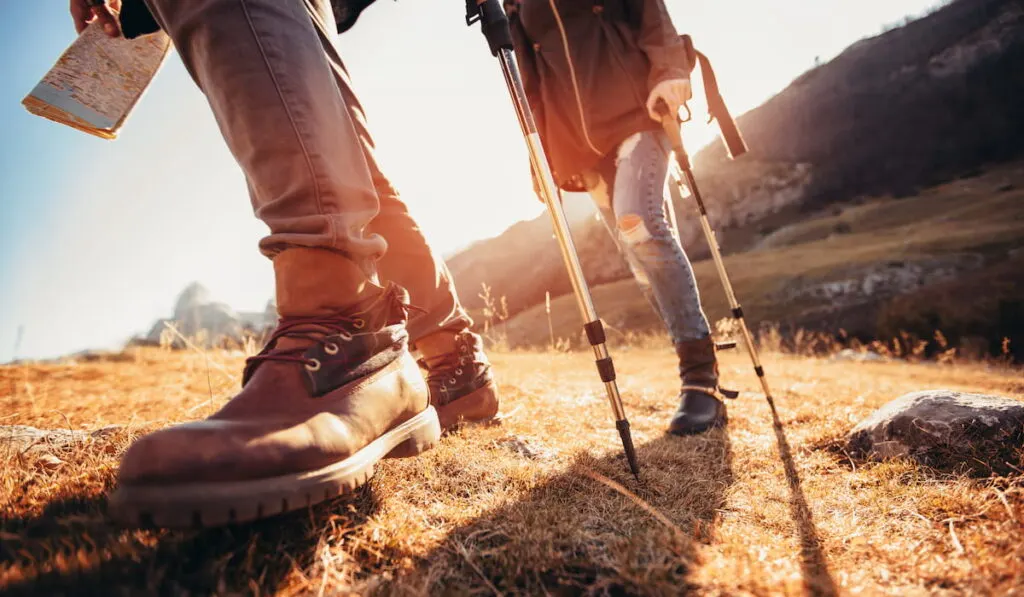Deciding on a winter hiking kit presents interesting challenges. Depending on where you’re hiking, it can be a difficult choice between a classic hiking boot and a more specialized snow boot.
The main question between snow boots and traditional hiking boots is usually related to weight and grip. Snow boots offer maximum grip designed to keep you on your feet in slippery, snowy conditions. They’re perfect for hikes at elevation. Hiking boots, on the other hand, offer a mix of grip and comfort in a lighter package.
Which one is the best boot hinges on what type of hiking you will do this winter.

Whatever you choose, ensure you have a pair of quality hiking boots for serious treks in wintry weather.
Quality footwear keeps you stable on the trail and prevents your feet from getting wet or too cold.
In addition, the proper boots will help you hike faster and feel better during hours of walking uphill in the snow, rain, and other conditions.
In this article, we break down the benefits of hiking boots and compare them with snow boots to help you choose what to wear for your upcoming hiking season.
Here’s how you can get the best results on your hike and keep going back for more.
Table of Contents
The Benefits of Snow Boots
Snow boots are built for moving around in the snow when stability and avoiding falling are your top priorities.
They are also made of thicker materials designed to keep your feet and lower legs warm in freezing weather.
Snow boots have the edge when it comes to staying warm, something you’ll be very thankful for when you’re up on a mountain in a foot or more of snow.
They are also waterproof, which keeps you dry as you shuffle around trails in the snow.
The bottoms of snow boots are typically made of thick rubber with a heavy tread that keeps water out and helps you keep your balance in everything from fresh powder to melting sludge.
On top of that, they come in different lengths depending on how high you want them up your leg.
In particularly cold weather, one of snow boots’ nicest features is that they can cover more of your leg with wool or some other warm material to protect you from the cold.
They also may have a tight cuff around the top that can lace up the boot completely to stop any water from getting through and into your socks.
Why People Love Hiking Boots
Hiking boots won’t be the best shoes you can wear hiking in a blizzard, but they’re a great choice for pretty much anything else.
Modern hiking boots are comfortable, provide stability, and are versatile.
You can buy hiking boots in a variety of rises and treads based on what types of hikes you’re doing and your experience on the trail.
Hiking boots may not give you as much tread as a heavy snow boot, but they’ll do a decent job.
You won’t find merino wool lining your hiking boots, but they’ll be almost as comfortable as a pair of your favorite tennis shoes.
People love hiking boots because they offer a fantastic mix of comfort and performance.
They are an all-around classic shoe designed for people who want to go places in different weather conditions.
You can hike up steep hills in them or walk through rivers. You can find waterproof hiking boots for wet hikes but still have the breathability you need for long treks.
They’re the ultimate all-year boot that you can count on to get you where you need to go.

Putting Both Boots Head-to-Head
Let’s look at both boots head-to-head to see which will suit you better.
Comfort
Snow boots will feel comfier if you’re standing still. The soft lining inside most boots feels like you’re putting your feet in a cozy blanket.
When trying them on, snow boots easily win the comfort test. Hiking boots will feel like putting on normal shoes or boots compared to soft, pillowy snow boots.
Weight
Snow boots will almost always weigh more than hiking boots.
This is because they’re heavy-duty shoes designed to keep your feet dry when it’s wet outside. And all that comfort adds extra pounds to the weighted total.
Hiking boots, though, are made with moving in mind. Manufacturers balance weight and performance to make the lightest boots possible that still deliver the stability their customers need.
Hiking boots take the win for people looking for lightweight shoes.
Weatherproofing
Snow boots edge out hiking boots in the category of weatherproofing because they’re made to trek through heavy snow and keep people dry in extreme wet conditions.
However, hiking boots do a decent job with waterproofing and durability. They’ll stand up to all but the most extreme cold weather.
Breathability
Snow boots are fantastic for shoveling the drive or walking around a ski resort.
They’re also a nice choice when hiking outdoors in deep snow.
However, snow boots lack breathability because they’re made to keep every bit of moisture out. If you hike in them for too long, your feet will start to sweat, and there is nowhere for the sweat to escape.
In snow boots, you’re more likely to deal with sweaty and hot feet, which could lead to fungal infections and, at the very least, discomfort when you walk.
Traction
If you’re walking in the snow, you’ll be glad you spent money on some nice snow boots. They make an enormous difference.
Every year, tons of people get injured trying to hike or just walk down the street in shoes that aren’t built for the snow. With snow boots, you can have incredible grip and traction on all types of snow.
Hiking boots are no slouch in this category, though. They give you a great grip on rocks, grass, and even light snow.
But, while a snow boot will make you more sure-footed when snow is coming down hard, hiking boots do a decent job everywhere else.

Usability
While it may seem like snow boots are winning more categories, hiking boots score a big win regarding usability and versatility.
For example, you’re not going to wear snow boots on a spring or summer hike. They’re much too heavy, and your feet will be swimming in sweat puddles because the lining will make them so hot.
One of the nicest things about a good pair of hiking boots is that you can use them practically all year, no matter where you go.
They will do just fine on a relaxed hike in the woods, and you can take them on a multi-day camping trip in the mountains.
Eventually, you can break in a pair of hiking boots to the point where they feel amazing on your feet.
Snow boots are usually way too heavy for normal trail hikes. You’ll be glad you left them at home in anything but very snowy conditions.
How to Choose the Right Boot for You?
Are you still having difficulty choosing the right boot for your time outdoors? Let’s dive into a bit more detail to help you decide.
If you’re living in Utah and skiing every year, then it’s certainly worth it to buy a good pair of snow boots.
You’ll feel a bit foolish walking around in the snow in hiking boots with your toes soaked in melted snow.
A good snow boot will keep you walking with confidence across fresh powder and every other type of snowy condition.
For everything else, hiking boots are your best bet. They will keep your feet dry and won’t give you a ton of blisters on your next hike.
They’re also a lot lighter, and you may even find yourself wearing them in light snowy conditions because you don’t want to hike in heavy snow boots unless you have to.

A hiking boot will get you through all but the snowiest of conditions.
If you’re a skier, snowboarder, or just love to hike in deep snow, then you will need a sturdy pair of snow boots to avoid getting wet and cold.
Of course, you will not want to wear them on your next summer camping trip.
Both boots will do fairly well in the same moderate conditions. But you’ll want hiking boots if you’re walking long distances.
While there is some overlap, our verdict goes to hiking boots for people who have to choose one over the other. There are many more scenarios where hiking boots are the more practical choice.
A Final Thought
If you can, though, get a pair of both! That way, you can break out the pair of boots best suited to the weather outside.
Then, read some reviews and, better yet, try on a bunch of boots until you find a great boot that feels comfortable on your feet.
Hiking boots and snow boots are both critical pieces of gear for hikers of all skill levels.

